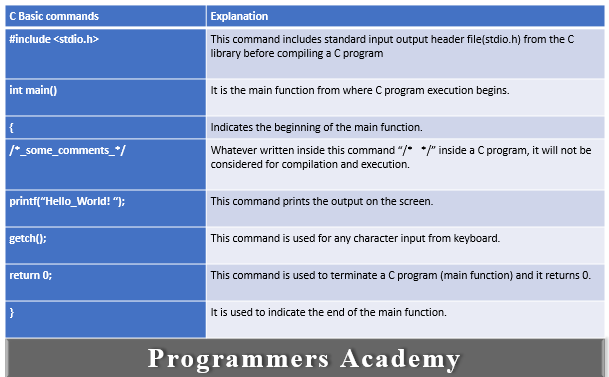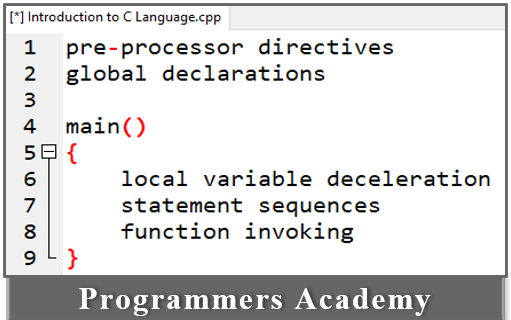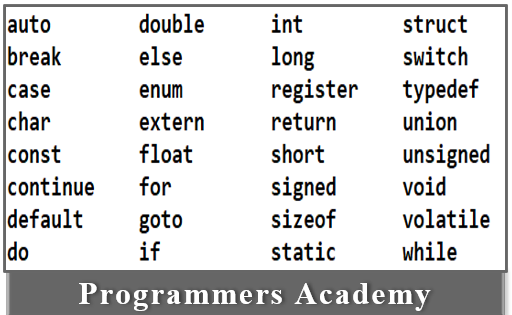What is C?
C is a procedural programming language. First developed by Dennis Ritchie in 1972. Developed primarily as a systems programming language for creating operating systems. Key features of the C language include low-level memory access, a simple keyword set, and clean styling. These characteristics make the C language suitable for system programming, such as operating system development and compilers.
Key Components of C Language:
- This programming language was created so that Unix could write with it.
- This language has B as its direct mother tongue developed in the 1970s.
- ANSI (American National Standards Institute) officially established this language as the official programming language in 1988.
- When it comes to system-friendly programming languages, there is no better choice than C.
- The latest generation software is created using the C language.
- The main reason for using C as a system-specific programming language is its speed and efficiency, which is close to that of assembly language.
- Program c has a .c extension.
Characteristics of C Language:
The main features of the C language are as follows.
- Simplified keyword set: Use a simplified, easy-to-understand and rich keyword set that meets one of the most important characteristics of this language.
- Clean style: the flow of the code is clean because the language focuses on organizing your code.
- Pointer Mechanism: The efficient use of pointer and addressing mechanisms in the C language has unique characteristics that differentiate it from all other programming languages.
- Efficient compiler design language: Light, rich and diverse set of commands and features, the ability to work very well on hardware, low memory usage, and so on. make it ideal for developing compiler layouts.
- This is a very robust language with a rich set of built-in operators and functions.
- C-encoded programs are fast and efficient.
- A highly portable language. This means that programs written in C can easily be run on a variety of other machines with little change.
- There is a large collection of libraries or built-in functions. It also offers the ability to customize or create your own functions for inclusion in the C library collection.
- It is a very extensible language.
Basic Commands of C Programming Language:

Features of C Programming Language:
Key features of the C language include low-level memory access, a simple keyword set, and clean styling. These characteristics make the C language suitable for system programming, such as operating system development and compilers.
1. Procedural language:
In a procedural language like C, predefined instructions are executed step by step. A C program can contain multiple functions to accomplish a particular task. Programming beginners will think that this is the only way a particular programming language works. There are also other programming paradigms in the world of programming. Most of the most widely used paradigms are object-oriented programming languages.
2. Fast and efficient:
New languages like java and python offer more functionality than c programming languages, but the additional processing in these languages effectively reduces throughput rates. The C programming language, which is a mid-level language, provides programmers with access to direct operations using computer hardware, but high-level languages do not allow it. This is one of the reasons why C is considered the first choice to start learning a programming language. Static writing languages are faster because they are faster than dynamic writing languages.
3. Modularity:
This programming language van does little by itself. The library has most of its capabilities. The C language has its own library to solve these common problems, and you can use the header files stored in the library to use specific functions.
4. Static writing:
The C programming language is a static writing language. That is, the variable type is checked at compile time, but not at run time. This means that every time the programmer enters a program, he must mention the type of variable used.
5. General-purpose languages:
From system programming to photo editing software, the C programming language is used in a variety of applications. Some of the common applications in which it is used are:
- Operating system: Windows, Linux, iOS, Android, OXS
- Database: PostgreSQL, Oracle, MySQL, MS SQL Server, etc.
6. Intermediate language:
Being an intermediate language, it has a format that combines both assembly language and high-level language functions.
7. Portability:
Programs written in C can be run and compiled on any system without or without changes, so C is generously portable.
8. Easy to expand:
Programs written in C are extensible. This means that if your program is already written, you can add a few more functions and operations.
9. Code reuse, customization and extensions:
Programmers can easily create their own functions. It can be used repeatedly for various purposes. A C program is basically a set of functions. This function is compatible with the “c” library. Functions can be continuously added to the ‘c’ library.
10. Limited number of keywords:
There are only 32 keywords in ‘C’. Ritchie gives 27 keywords. 5 is added by ANSI. The strength of “C” lies in its built-in functions. Unix systems provide several C functions. Some functions are used during operation. Others are specific to that application.
Program Structure of C Programming Language:

Keywords that use C language:

Advantages of C Language:
- A C program is a collection of functions from the C library and it is easy to add functions to the C library.
- There are some standard features (such as embedded) that you can use to develop your program.
- Modular construction makes it easy to debug, maintain, and test code.
- It is a highly portable language and is interoperable.
- All 32 keywords that exist as part of the built-in function exist in ANSI-C. Besides that, user-created functions are also widely used.
- This language can be expanded with many other library functions.
- The modular structure of the programming language makes debugging, testing, and programming the language much easier.
Disadvantages of C Language:
- C does not provide the concept of object-oriented programming (OOP).
- C does not provide binding or wrapping of data on a single drive.
- C does not provide a constructor or destructor.
- A strict type check is not possible.
- No runtime verification
- Also, there is no concept of constructors and destructors.
References:
- https://www.geeksforgeeks.org/c-language-set-1-introduction/#:~:text=It%20was%20mainly%20developed%20as,operating%20system%20or%20compiler%20development.
- https://www.guru99.com/c-programming-language.html
- https://fresh2refresh.com/c-programming/c-basic-program/
- https://www.w3schools.in/c-tutorial/intro/

